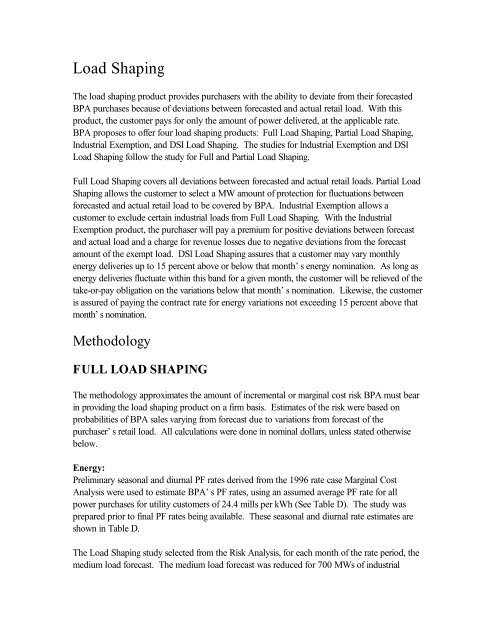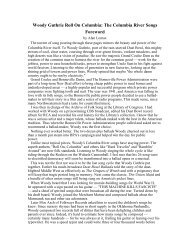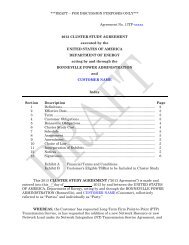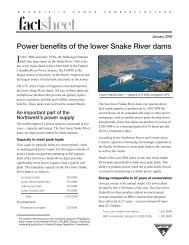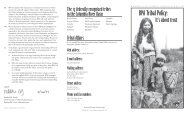Load Shaping - Bonneville Power Administration
Load Shaping - Bonneville Power Administration
Load Shaping - Bonneville Power Administration
Create successful ePaper yourself
Turn your PDF publications into a flip-book with our unique Google optimized e-Paper software.
<strong>Load</strong> <strong>Shaping</strong><br />
The load shaping product provides purchasers with the ability to deviate from their forecasted<br />
BPA purchases because of deviations between forecasted and actual retail load. With this<br />
product, the customer pays for only the amount of power delivered, at the applicable rate.<br />
BPA proposes to offer four load shaping products: Full <strong>Load</strong> <strong>Shaping</strong>, Partial <strong>Load</strong> <strong>Shaping</strong>,<br />
Industrial Exemption, and DSI <strong>Load</strong> <strong>Shaping</strong>. The studies for Industrial Exemption and DSI<br />
<strong>Load</strong> <strong>Shaping</strong> follow the study for Full and Partial <strong>Load</strong> <strong>Shaping</strong>.<br />
Full <strong>Load</strong> <strong>Shaping</strong> covers all deviations between forecasted and actual retail loads. Partial <strong>Load</strong><br />
<strong>Shaping</strong> allows the customer to select a MW amount of protection for fluctuations between<br />
forecasted and actual retail load to be covered by BPA. Industrial Exemption allows a<br />
customer to exclude certain industrial loads from Full <strong>Load</strong> <strong>Shaping</strong>. With the Industrial<br />
Exemption product, the purchaser will pay a premium for positive deviations between forecast<br />
and actual load and a charge for revenue losses due to negative deviations from the forecast<br />
amount of the exempt load. DSI <strong>Load</strong> <strong>Shaping</strong> assures that a customer may vary monthly<br />
energy deliveries up to 15 percent above or below that month’s energy nomination. As long as<br />
energy deliveries fluctuate within this band for a given month, the customer will be relieved of the<br />
take-or-pay obligation on the variations below that month’s nomination. Likewise, the customer<br />
is assured of paying the contract rate for energy variations not exceeding 15 percent above that<br />
month’s nomination.<br />
Methodology<br />
FULL LOAD SHAPING<br />
The methodology approximates the amount of incremental or marginal cost risk BPA must bear<br />
in providing the load shaping product on a firm basis. Estimates of the risk were based on<br />
probabilities of BPA sales varying from forecast due to variations from forecast of the<br />
purchaser’s retail load. All calculations were done in nominal dollars, unless stated otherwise<br />
below.<br />
Energy:<br />
Preliminary seasonal and diurnal PF rates derived from the 1996 rate case Marginal Cost<br />
Analysis were used to estimate BPA’s PF rates, using an assumed average PF rate for all<br />
power purchases for utility customers of 24.4 mills per kWh (See Table D). The study was<br />
prepared prior to final PF rates being available. These seasonal and diurnal rate estimates are<br />
shown in Table D.<br />
The <strong>Load</strong> <strong>Shaping</strong> study selected from the Risk Analysis, for each month of the rate period, the<br />
medium load forecast. The medium load forecast was reduced for 700 MWs of industrial
exemptions and reduced by Tacoma’s load. The <strong>Load</strong> <strong>Shaping</strong> study selected from the Risk<br />
Analysis, for each month of the rate period, the positive and negative deviations from the<br />
medium load forecast of total retail load associated with economic conditions that had 30% and<br />
10% probabilities of occurrence, and assumed 20% probability of zero deviation. Positive and<br />
negative deviations for five weather conditions with the same probability distribution were<br />
determined. This yields 25 joint probability distributions for each month for the study, and<br />
resulting amounts of load deviation. (See Table A, fn. 6&8).<br />
Each of the 25 deviations for each diurnal period during each month were added to the amount<br />
of BPA planned purchases from NFRAP in the case of positive total deviations, or added as<br />
the next increment of sales to the Pacific Southwest from NFRAP in the case of negative total<br />
deviations. The purchase quantities (positive deviations) associated with those 25 deviations<br />
were inserted into the total purchase rate equation (See Table C). The sales quantities<br />
(negative deviations) associated with the 25 deviations were inserted into the total sales<br />
equations (See Table F), resulting in the next lower nonfirm sale price. As described in our<br />
supplemental direct and rebuttal testimony the purchase and sale equations have been changed<br />
for the final <strong>Load</strong> <strong>Shaping</strong> Analysis to be based on the Marginal Cost Analysis<br />
The study next calculates the difference between the incremental purchase cost in the case of<br />
positive deviations, or next lower nonfirm sale price in the case of negative deviations, and the<br />
estimated PF rate for each month and diurnal period. Negative differences are benefits to BPA<br />
and positive differences are costs to BPA. The quantity of each of the 25 deviations is<br />
converted to a percent of the medium load forecast and that percent is multiplied by the<br />
probability of the economic condition, the probability of the weather condition, and the<br />
difference between the PF rate and the incremental cost or decremental revenues for that<br />
deviation. The results are summed by diurnal period and month and weighted in proportion to<br />
the number of heavy and light load hours (See Tables FY97 - FY01 fn 8), to develop a cost<br />
per kilowatt-hour of medium forecast load. The results are converted to present value by month<br />
for the rate period using a 7.8% discount rate (See Table G).<br />
Demand:<br />
The deviation in peak demand was assumed to be proportional to the energy deviation. The<br />
proportionate amount of deviation associated with worst case weather conditions in each month<br />
is added to the proportionate amount of deviation associated with each economic scenario.<br />
These deviations were multiplied by the probability of each economic scenario (See Table E fn<br />
4). This product was multiplied by the value of capacity, from BPA’s rate proposal, by month<br />
as shown in Table E, which is $0.87 per kW-mo., for the 5 year rate period. These probability<br />
weighted costs were summed across the five economic scenarios to get an expected cost by<br />
month for the rate period. Each of the monthly costs were then divided by the number of hours<br />
in each month to get a mills per kWh cost. These costs were converted to present value by<br />
month over the 5 year period at a 7.8% discount rate (See Table G).
Results<br />
The present value of the costs for energy and capacity were summed by month. The values<br />
were then levelized by month over the 5 year rate period, at a 7.8% discount rate. The monthly<br />
levelized values were averaged and rounded to get a single average annual cost (See Table G).<br />
The total cost of Full <strong>Load</strong> <strong>Shaping</strong> is 0.32 mills per kWh. (See Table G)<br />
PARTIAL LOAD SHAPING<br />
To determine the charge for Partial <strong>Load</strong> <strong>Shaping</strong>, BPA estimated total Full <strong>Load</strong> <strong>Shaping</strong><br />
revenues assuming all 1981 and 1996 power sales contract PF customers purchased Full <strong>Load</strong><br />
<strong>Shaping</strong> for their entire load (Tacoma and Industrial Exemption loads were excluded) and<br />
dividing those revenues by the average monthly deviation in aMW times the average hours in a<br />
month (730). This results in a rounded per MWh per hr. cost of $2.27. (See Table G, line 50,<br />
column H).<br />
INDUSTRIAL EXEMPTION<br />
The Industrial Exemption allows any customer purchasing Full <strong>Load</strong> <strong>Shaping</strong> to exempt an<br />
industrial load from Full <strong>Load</strong> <strong>Shaping</strong>. It is generally used for loads of 5 aMW or larger. For<br />
1981 Contract purchasers, the exemption results in a reduction in the amount of BPA deliveries<br />
to which Full <strong>Load</strong> <strong>Shaping</strong> charges apply. For 1996 Contract purchasers, the exempted<br />
industry’s load is excluded from total retail load to which the Full <strong>Load</strong> <strong>Shaping</strong> charge applies.<br />
Industrial Exemption is available to customers who have industrial loads that are predictable<br />
enough that a forecast made two months prior to the start of the billing month can accurately<br />
describe the monthly HLH energy and LLH energy for the load. With an Industrial Exemption,<br />
the customer pays an Industrial Exemption load shaping charge for the difference between<br />
forecast and actual Industrial Exemption loads.<br />
The customer will provide BPA with a monthly forecast of heavy load hour (HLH) energy and<br />
light load hour (LLH) energy for each exempt industrial load. When actual energy use is less<br />
than forecast the customer will pay for that load shaping for the Industrial Exemption load at the<br />
rate of 1.16 mills/kWh on the difference between forecast and actual energy use. For actual<br />
hourly energy use above forecast, the customer will pay for load shaping for the Industrial<br />
Exemption load at the rate of 1.16 mills/kWh on the difference between forecast and actual<br />
energy use. If the customer varies from the forecast by more +1/-5% for more than one month<br />
out of any six-month period, the load may lose the exemption. Details of the rights of deviations<br />
for exempt industrial loads and of the test are stated in the GRSP sections relating to Industrial<br />
Exemption.
The study was done using PF rates, the average non-firm sales rate from the Full <strong>Load</strong> <strong>Shaping</strong><br />
analysis and the average cost of purchased power plus purchased capacity from the Full <strong>Load</strong><br />
<strong>Shaping</strong> analysis (see Table H). The study assumed a subscription of 700 MWs of plant<br />
capacity for the Industrial Exemption product, based on a forecast of load that would qualify for<br />
the exemption, a maximum curtailment of 5% (the limit of coverage under this product) and a<br />
probability of the outage occurring of 10% in any month. That probability was chosen to allow<br />
a reasonable amount of curtailment for a stable industrial load. The study calculates the number<br />
of MWhs of outage that could occur in each month, as the product of the 5% negative deviation<br />
bandwidth times expected Industrial Exemption of 700 MWs times the hours in each<br />
month.(see Table J fn 1). The study assumed that the MWhs of reduction from forecast were<br />
sold as nonfirm energy to the Pacific Southwest. The value of those sales is estimated from the<br />
Full <strong>Load</strong> <strong>Shaping</strong> Analysis (see Table H). The difference between the PF and nonfirm sales<br />
price was then multiplied by the outage in MWh times the assumed probability of the outage<br />
occurring in this month (10%) (The probability of outage, and of overruns, has been revised to<br />
correct an error in the supplemental Industrial Exemption Analysis). This procedure was<br />
duplicated for each month of each year in the rate period. The monthly values were summed<br />
and the resulting annual values were then converted to present value and levelized using a 7.8%<br />
discount rate to get five-year costs.<br />
The study calculates the number of MWhs of energy overruns that could occur in each month,<br />
as the product of the 1% positive deviation bandwidth times expected Industrial Exemption of<br />
700 MWs times the hours in each month.(see Table J fn 10). The study assumed that BPA<br />
purchased the MWhs of energy overrun on the surplus firm market at the average of the<br />
purchase prices from the Full <strong>Load</strong> <strong>Shaping</strong> Analysis (see Table H fn 2). The difference<br />
between the PF rate and surplus-firm purchase price was then multiplied by the outage in<br />
MWhs times the assumed probability of the overrun occurring in that month (10%). This<br />
procedure was duplicated for each month of each year in the rate period. The monthly values<br />
were summed and the resulting annual values were then converted to present value and levelized<br />
using a 7.8% discount rate to get five year costs.<br />
The levelized costs of positive and negative deviations were summed and rounded to 1.16<br />
mills/kWh.<br />
DSI LOAD SHAPING<br />
Determining the Amount of Variation Around Monthly Nomination<br />
BPA determined the likelihood of up to a 15% increase or decrease in actual firm energy<br />
deliveries from the medium forecast of non-aluminum DSI load. BPA assumed a 25% chance<br />
of both a 15% overrun and a 15% underrun. Multiplying the MW quantity of fluctuation by the<br />
probability of the fluctuation results in an estimate of the expected MW fluctuation.
Product Cost<br />
Energy<br />
BPA first developed a set of 5-yr. IP rates using the average delivered IP rate of<br />
22.6 mills/kWh and applying the marginal costs from the MCA to arrive at monthly HLH and<br />
LLH IP rates.<br />
For energy deliveries in excess of a month’s nomination, BPA will either make additional<br />
purchases to meet these deliveries or forego an alternate sales opportunity. Such purchases or<br />
foregone sales are assumed to be at the nominal market firm power price for each month in<br />
each year from the Full <strong>Load</strong> <strong>Shaping</strong> product study.<br />
For energy deliveries below a month’s nominations, BPA will sell into the nonfirm market at the<br />
monthly nonfirm energy prices. Such sales are assumed to be made at the nominal nonfirm<br />
market price for each month of each year from the Full <strong>Load</strong> <strong>Shaping</strong> product study. BPA sells<br />
into the non-firm market because BPA cannot know whether the customer will take delivery of<br />
the nominated amounts until the workday before delivery. The energy sold into the nonfirm<br />
market will have a price lower than the delivery price, while the cost of energy purchased to<br />
meet additional deliveries may be either above or below BPA’s firm energy rate.<br />
Demand<br />
The deviation in peak demand was assumed to be proportional to the energy deviation. The<br />
cost of additional demand is captured by including capacity costs in the on-peak power<br />
purchase prices used to cost deviations in excess of a months nominations. See the table<br />
labeled Development of Estimated IP Firm Energy Prices and Spot Firm Market Prices<br />
footnote 4.<br />
Determining the Total Cost of DSI <strong>Load</strong> <strong>Shaping</strong><br />
The additional expected energy deliveries were multiplied by the difference between the firm<br />
purchase price and the assumed IP rate for that month, and the deliveries below medium<br />
forecast were multiplied by the difference between the nonfirm price and the assumed IP rate.<br />
Then, for each month, these amounts are summed to obtain the estimated cost of providing this<br />
service for that month. This estimated cost was then divided by the Calculated Energy Capacity<br />
for that month. Next, the present value of each month’s cost was determined for the 5-year<br />
rate period, using a 7.8% discount rate. Next, monthly levelized costs were determined for<br />
each month in the 5-year rate period. A monthly levelized cost was determined for each month<br />
using the monthly costs for each year and a discount rate of 7.8 percent. Finally, one cost of<br />
$201/CEC/month was determined by taking the simple average of the 12 levelized costs.
Determining Product Price and Billing Factor<br />
The price of $201 per aMW per month of Calculated Energy Capacity was calculated as<br />
described above. The “Calculated Energy Capacity” is BPA’s estimate of average monthly firm<br />
energy use for DSI plants operating at full capacity based on historical data. Details of the the<br />
determination of Calculated Energy Capacity may be found in the GRSPs relating to Calculated<br />
Energy Capacity.<br />
Utility Factor<br />
BPA multiplies the charge for Full <strong>Load</strong> <strong>Shaping</strong> and <strong>Load</strong> Regulation by the Utility Factor for<br />
customers purchasing those products under the 1981 <strong>Power</strong> Sales Contract. The Utility Factor<br />
is designed to ensure an equitable allocation among customers of the cost of those services.<br />
The factor modifies the Full <strong>Load</strong> <strong>Shaping</strong> and <strong>Load</strong> Regulation rates to create a more direct<br />
relationship between the costs incurred by BPA for providing these services to specific<br />
customers and the actual charge assessed.<br />
The cost of providing the Full <strong>Load</strong> <strong>Shaping</strong> and <strong>Load</strong> Regulation services is related to the size<br />
of the customer’s retail load, not to the amount of power the customer purchases from BPA.<br />
Without the Utility Factor adjustment, those customers that purchase only a portion of their<br />
power from BPA would pay proportionately less for the <strong>Load</strong> <strong>Shaping</strong> and <strong>Load</strong> Regulation<br />
services than those customers that purchase all of their power from BPA. The application of the<br />
Utility Factor adjusts the customer’s Full <strong>Load</strong> <strong>Shaping</strong> and <strong>Load</strong> Regulation rate such that the<br />
cost paid by each customer for these services is relative to the size of their retail load. Because<br />
some customers may have extremely large Utility Factors, BPA will cap Utility Factors at six.<br />
BPA’s estimate of customer Utility Factors is included in this documentation.<br />
BPA will use the following methodology to calculate the Utility Factor for each Fiscal Year, with<br />
information from the following sources, if provided by the utility, or using BPA’s estimate of the<br />
necessary information:<br />
1. BPA power bills<br />
2. Customer Financial and Operating Report (end of year)<br />
3. Generation Report(s) (where applicable)<br />
BPA will calculate a purchaser’s Total Retail <strong>Load</strong> for the previous Calendar Year by<br />
aggregating all energy (kWh) purchased and/or generated to meet load during the Calendar<br />
Year. This calculation will be made from the information described above submitted by the<br />
purchaser to its BPA Account Executive or District Sales Office for the previous Calendar<br />
Year. If the purchaser fails to submit a Financial and Operating Report, and Generation Report<br />
as applicable, by June 1 following the Calendar Year, BPA will prepare an estimate of the<br />
purchaser’s Total Retail <strong>Load</strong> for the previous Calendar Year, after consultation with the
purchaser. For the purpose of determining the Utility Factor for the Full <strong>Load</strong> <strong>Shaping</strong> charge<br />
only, Total Retail <strong>Load</strong> is adjusted to exclude New Large Single <strong>Load</strong>s served with dedicated<br />
resources pursuant to section 8(e) of the 1981 Contract.<br />
Utility Factor for the applicable Fiscal Year for Metered Requirements customers = Total Retail<br />
<strong>Load</strong> for the previous Calendar Year, adjusted for the Full <strong>Load</strong> <strong>Shaping</strong> charge only to<br />
exclude New Large Single <strong>Load</strong>s served with dedicated resources pursuant to section 8(e) of<br />
the 1981 Contract ÷ Energy Purchases under the 1981 Contract for the previous Calendar<br />
Year. For Actual Computed Requirements customers, the divisor is Computed Energy<br />
Maximum for the previous Calendar Year. If the Utility Factor as calculated by the foregoing<br />
formula exceeds six, the Utility Factor will be capped at six.<br />
For customers who choose an Industrial Exemption, an Adjusted Utility Factor is calculated for<br />
the Full <strong>Load</strong> <strong>Shaping</strong> charge on a monthly basis. The calculation for the Adjusted Utility<br />
Factor for Metered Requirements customers is as follows: (1/12 times the customer’s Total<br />
Retail <strong>Load</strong> for the applicable calendar year, excluding New Large Single <strong>Load</strong>s served with<br />
dedicated resources, minus the Industrial Exemption forecast for the current month) divided by<br />
(1/12 times the customer’s BPA purchases for the applicable calendar year, excluding New<br />
Large Single <strong>Load</strong>s served with dedicated resources, minus the Industrial Exemption forecast<br />
for the current month). The calculation of the Adjusted Utility Factor for Actual Computed<br />
Requirements customers is: (1/12 times the customer’s Total Retail <strong>Load</strong> for the applicable<br />
calendar year, excluding New Large Single <strong>Load</strong>s served with dedicated resources, minus the<br />
Industrial Exemption forecast for the current month) divided by (1/12 times the customer’s<br />
Computed Energy Maximum for the applicable calendar year, excluding New Large Single<br />
<strong>Load</strong>s served with dedicated resources, minus the Industrial Exemption forecast for the current<br />
month).<br />
The Full <strong>Load</strong> <strong>Shaping</strong> and <strong>Load</strong> Regulation charges are multiplied by the Utility Factor to<br />
determine the rates for Full <strong>Load</strong> <strong>Shaping</strong> and <strong>Load</strong> Regulation. For customers with Industrial<br />
Exemption load, the Full <strong>Load</strong> <strong>Shaping</strong> charge is multiplied by the Adjusted Utility Factor to<br />
determine the Full <strong>Load</strong> <strong>Shaping</strong> rate. In determining the Utility Factor and Adjusted Utility<br />
Factor for Full <strong>Load</strong> <strong>Shaping</strong>, New Large Single <strong>Load</strong>s served with dedicated resources<br />
pursuant to section 8(e) of the 1981 Contract are excluded from Total Retail <strong>Load</strong>. The divisor<br />
for both the Utility Factor and Adjusted Utility Factor for Metered Requirements customers is<br />
BPA purchases, and for Actual Computed Requirements customers is Computed Energy<br />
Maximum.<br />
<strong>Bonneville</strong> has updated the following table of Calendar Year 1994 Utility Factors from the<br />
supplemental proposal only to re-calculate Utility Factors for Actual Computed Requirements<br />
customers using Computed Energy Maximum for the divisor instead of BPA purchases. BPA<br />
will be preparing updated Utility Factors with customers in the manner described above.


